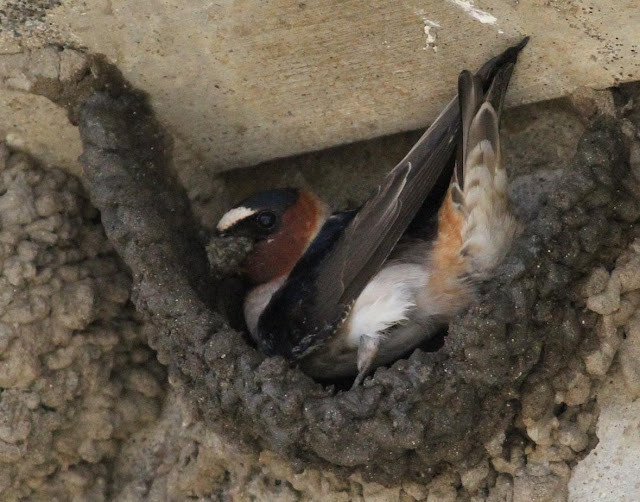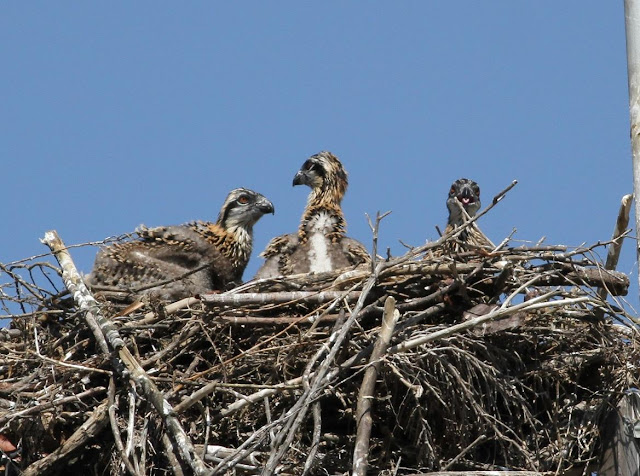I'm still feeling sad about the closing of our beautiful
Rios Ave west trail and the Pole Road trail for the expansion of the railroad tracks. As I
visit the trail that I have chosen for a replacement for Rios, I try to get acquainted with the regular birds that reside along the San Dieguito Lagoon Coast to Crest Trail this time of year. There is nothing more uplifting for any birder's mood than observing the
wild activity of busy Cliff Swallows building nests on the side of the freeway
or watching precious nestlings peeking over their nest. Not just any nestling...
but three beautiful wonderful Osprey nestlings!
Starting at the San Andres Dr trail head I headed west towards the Osprey's nest and approached the I-5 freeway
underpass. Cliff Swallows are busy flying up to the under ledge of the freeway
bridge. The cement structure that spans the San Dieguito River makes for a
perfect place to build their mud ball nests. Here is a shot of the ambitious
Cliff Swallows making their "mud hut" nest.
Cliff Swallow, Petrochelidon
pyrrhonota measures 5.5 inches long with a wingspan of 13.5
inches. A male may start the nest building before he attracts a mate. Both male
and female will help in building the nest.
Below, a Cliff Swallow is just starting the process of
building his nest. He has already made a few dozen trips to the nearby mud bank.
He brings back a beak full of mud and places it on the
wall. Some mud balls will fall off as he lays the foundation to his nest.
His neighbor to the right already has his nest almost
all completed. He and his mate have made over 1000 trips bringing back balls of
mud and with careful placement have built a nice little nest. Now they must
guard it from intruders that want to take over their nest. One appears to always
be on the nest waiting for the partner to get back with the beak full of mud.
As our guy on the far left of the photo is busy placing
the mud ball on the foundation of his nest, his neighbor's mate returns with
another beak full of mud. The swallow on our right is busy working on building
up the outer edge of his newly formed nest. You can see all the work that he has
done today because the mud is still wet.
The swallow in the center of this photo has to make
room for his mate that just flew in with a beak full of fresh mud. To our far
right, there is a nest that is almost fully completed. The swallow is working on
the entrance of the nest and will fill the inside with dry grass.
The pair in the newly constructed center nest is
carefully carrying out the shift change. One will have to leave to make room the
the other.
One leaves. He will go and get another beak full of mud.
The mate has brought with her a mouthful of mud and
will continue the build-up of the outer wall.
This photo shows the different stages of nest building.
The far left one is still at the foundation stage. The second from the left is
halfway done with his walls. The third from the left is working hard to
build up the outer walls and the nest to our far right is all done and the future mother may
already be working on her egg laying.
A little bit of an altercation. The nest builder on the
second from the right sends his neighbor a message by banging into the
foundation building swallow. He may be saying "Stay away from my nest because
I'm coming right back". Regardless, it appears to be a very aggressive
move.
The swallow building his foundation is not deterred. He
goes right back to his work. The one to our right is also keeping busy.
I spot another nest that appears to be on top of one
that is already completed. A swallow flies up to the nest but there is a
confrontation with the one already sitting in the nest. It appears that the one
sitting in the nest is an intruder and the one that just arrived wants him
gone!
This is when a bonded pair has more leverage. The
intruder is told to get going as the owner of the nest is backed up by his mate
flyng in.
The two attack the one that was sitting in the nest and
let him know he is not welcome here. The neighbor below in the completed nest
peeks out to see what the commotion is all about.
With teamwork, they persuade
the intruder to leave.
The intruder flies off.
This time, one will stay and guard the nest as the
other gets more mud.
I spot another shift change as one partner flies in
with a mud ball and the other makes room for her to land.
Time for the one to leave.
The one working on the wall is reluctant and the one
with the beak full of mud pushes gently into the nest. Hint hint!!!
It works and he finally gets going.
Now it is her turn to add to the wall.
More mud here!
Really packs it in with her beak.
LOL... Only about 872 more trips bringing back mud balls and it will be all
done!
Each ball of mud is added and worked into the existing
mud balls. The mud balls bond to each other eventually forming a gourd-shaped
nest.
This is a dirty job.
Trying out the fit and comfort of the nest.
Many other Cliff Swallows are busy gathering mud from the
river bank below.
Some are leaving with a beak full of mud as others
arrive to take their place.
The mud must be just the perfect consistency at this
bank. There appears to be some waiting to land just in the perfect spot to
retrieve their mud.
This guy has just started his building. He has one
good dollop on the wall and wants to place his next mud ball to start the new
foundation for his nest.
Slap slap slap. The mud refused to stay.
He isn't giving up. Just resting for a second. It
doesn't look very easy hanging on to the side of the cement wall.
"Maybe it will stick here.."
"If I trowel and smear it across the dry cement just like
this...MAYBE it will stick".
Yes, it sticks! LOL, watching these swallows is fun but
I want to check out the Osprey nest so I leave the nest building swallows and
walk west along the San Dieguito Lagoon.
Arriving at the nest site, I can see that the mom is
in the nest with three nestlings!
Here is one alert and looking for dad to bring dinner.
The pinfeathers are coming in. Each feather is in a
quill shaft that is starting to unfurl. They are replacing the downy nestling
feathers. Soon they will be covered with real feathers. What an adorable stage.
A jogger comes by and startles the mom. She flies off
the nest and circles back.
Decides that she is going to perch on the top of the
pole affixed to the nest building platform.
Coming in for the landing.
Slowing, she grabs for the top of the post as she
glides upward.
The grab.
You do not want to be a fish and see these magnificent
talons coming at you.
The nestlings are alert and looking around. There is a
whole new world out there and soon they will taste the freedom of flight.
You can really see the pinfeathers coming out around
their necks. The sun is out and they cool off by panting like a dog.
Their eyes are amber in color. When
they mature, they will turn golden yellow. Look at all the pinfeathers coming in
on the wings!
Three beautiful nestlings!
One last shot and it's time for me to retrace my steps eastwards.
A shot of mom waiting for dad to bring dinner.
A beautiful male Kestrel flies by.
He turns and I get a nice shot of his leading edge.
A beautiful display of his tail coloring.
In a few minutes he returns carrying a nice-sized lizard. He heads to a tall palm tree. I wonder to myself if he is taking the
prey to his nestlings. Hope to see more of him too as I
return to this beautiful area to see the Osprey nestlings turn into fledglings.
Going east past the bridge again heading home, I notice that
it is about 3:30pm and all the swallows are gone! I would love to know where
they are. Maybe they are feeding all at once. They are known to travel, hunt and
nest together in huge groups. When the prey (mostly swarming insects) gets scarce
and hard to find, a swallow that is successful in finding prey will alert others
to the hunting ground. All info is from Cornell Lab of Ornithology at https://www.allaboutbirds.org/guide/Cliff_Swallow/lifehistory.
Have a super weekend everyone!




























































This was so well documented with all your excellent photos, Jo. I will share it with our Ocean Hills Birdwatchers group. On Friday, April 28 we are visiting Agua Hedionda Discovery Center where the cliff swallows are also nesting in large numbers.
ReplyDeleteThank you for visiting our blog and for your kind comments. I will be checkering out the Agua Hedionda area too.
Delete